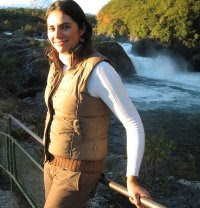

Charles Darwin fue testigo desde Ancud Chiloé de la erupción del volcán Osorno. El joven tripulante del Beagle escribió sobre el Osorno, en noviembre de 1834:
"La madrugada es admirable. El volcán de Osorno vomita torrentes de humo. Esta magnífica montaña, que forma un cono perfecto recubierto por completo de nieve, se eleva ante la Cordillera. Pequeños chorros de vapor se escapan también del inmenso cráter de otro volcán cuya cumbre presenta la forma de una silla de montar".
El 19 de enero de 1835, Charles Darwin presencia una erupción del Osorno. Con datos errados sobre una erupción simultánea en el Aconcagua, que en ese entonces se tenía por volcán ideo el naturalista una teoría sobre las posibles conexiones subterráneas a lo largo de la Cordillera de Los Andes, asociando ambos hechos. Veamos el relato:
"El 15 de enero de 1835 salimos del puerto de Low, y tres días más tarde echamos el ancla por segunda vez en la bahía de San Carlos, en la isla de Chiloé. Durante la noche del 19 el volcán Osorno se pone en erupción. A medianoche el centinela observa algo que se parece a una gran estrella; ésta aumenta a cada instante, y a las tres de la madrugada asistimos al más magnífico de los espectáculos. Con ayuda del telescopio, vemos en medio de espléndidas llamas rojas, negros objetos proyectados incesantemente al aire, que después caen. El fulgor es suficiente para iluminar el mar. Durante la mañana, el volcán recobra su tranquilidad."
"He quedado muy sorprendido al saber más tarde que el Aconcagua, en Chile, 480 millas más al Norte, se puso en erupción durante la misma noche, y me asombré más aún al llegar a mí noticias de que la gran erupción del Coseguina, 2700 millas al Norte del Aconcagua, erupción acompañada de un terremoto que se hizo sentir en un radio de 1000 millas, había tenido lugar seis horas después. Es difícil aventurarse incluso a conjeturar si esa coincidencia es accidental o si hay que ver en ello la prueba de alguna comunicación subterránea."
Todos esos lugares que conoció este importante pensador del siglo XIX puede conocerlo en nuestra ruta turística.
Darwin and the volcano Osorno
Charles Darwin the young crew member of the Beagle was witness from Ancud Chiloé of the eruption of Osorno volcano wrote on the Osorno, in November of 1834:
"the dawn is admirable. The volcano of Osorno vomits smoke torrents. This magnificent mountain, that forms a completely covered perfect snow cone, rises before the Mountain range. Small steam spurts also escape of the immense crater of another volcano whose summit presents/displays the form of a chair to mount ".
The 19 of January of 1835, Charles Darwin is present at an eruption of the Osorno. With data missed on a simultaneous eruption in the Aconcagua, that in that then was had by volcano I devise the naturalist a theory on the possible underground connections throughout the Mountain range of The andes, associating both facts. Let us see the story:
"the 15 of January of 1835 we left the port of Low, and three days later we threw the anchor for the second time in the bay of San Carlos, in the island of Chiloé. During the night of the 19 Osorno volcano is put in eruption. Midnight the sentry observes something that is looked like a great star; this one increases constantly, and three of the dawn we attended most magnificent of the spectacles. With aid of the telescope, we see in the middle of splendid red flames, black objects projected incessantly to the air, that later fall. The fulgor is sufficient to illuminate the sea. During the morning, the volcano recovers its tranquillity."
"I have been very surprised the knowledge later that the Aconcagua, in Chile, 480 miles more to the North, was put in eruption during the same night, and I was still more astonished when arriving at me the news that the great eruption of the Coseguina, 2700 miles to the North of the Aconcagua, eruption accompanied by an earthquake that was made feel in a radius of 1000 miles, had taken place six hours later. It is difficult to venture itself to even conjecture if that coincidence is accidental or if there is to see in it the test of some underground communication."
All those places that this important thinker knew century XIX can know it in our tourist route.







